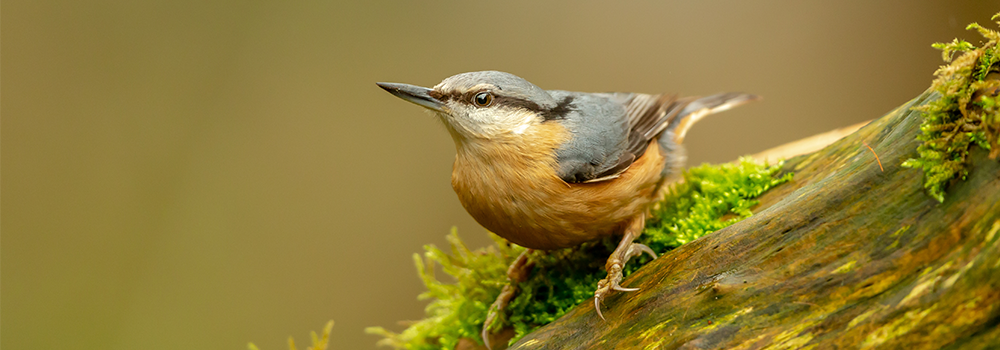Common UK bird species
With nearly 600 species of bird officially listed in the UK, birdwatching can be enjoyed just about anywhere, you don’t need to travel far. We take a look at some of the most common bird spices that you may find in your local area.

Blue Tit
For the best chance of spotting birds, head to your local nature reserve or wooded area – both which can be found on OS Maps. More common birds can also be found in greenspaces such as a park or garden. The greenspace layer in OS Maps is a simple to use map layer showing all the different types of greenspace across Great Britain.
Before you step out the door, it will help to be able to identify the most common UK birds seen below. How many you spot?
The European robin (erithacus rubecula)

The robin is one of Britain’s most recognisable birds. It’s rare enough to justify pointing one out to a friend or family member while still being a perfectly achievable spot. With an average length of around 13cm and that hard-to-miss red chest, robins can be found in gardens and green spaces across the country.
Believe it or not, not all robins have such brightly coloured chests like the ones we see on Christmas cards every year; the species commonly found in other parts of Europe, such as Russia and Scandinavia, possess subtler tones and often migrate to Britain when it gets too cold back home.
Starlings (sturnus vulgaris)

Starlings are among the country’s more interesting garden visitors. These birds can provide plenty of entertainment for those who like to spend time spotting from their own patios or rear windows, as they have a particularly distinctive strutting walk. It’s also normal to see them in more open spaces, such as country parks and fields.
Starlings have a special mimicking talent, which means they’re able to copy the sounds of other birds and even some mammals. Normally, though, their song combines a range of calls, clicks and whistles, making them easier to find. While adult starlings’ plumage tends to look black, they’re actually iridescent. With the right light, it’s possible to capture the stunning mix of colours on camera or through binoculars – this alone makes it a great bird to look out for.
The best time to look for starlings is undoubtedly during autumn. It is around then that they come together in their thousands to put on spectacular air displays, creating all kinds of shapes in the sky.
Peregrine falcons (falco peregrinus)
The peregrine is high on many British birdwatchers’ lists. This large, powerful falcon is one of the country’s rarer birds of prey and has an average wingspan of around 110cm, making it easy to spot for those who do find themselves in the right place at the right time. That said, they’re actually among the world’s fastest birds, and are known to travel at speeds as high as 50mph.

In terms of finding the right place, peregrines are most commonly found in the north and west of the UK, although some migrate to southern England during autumn and winter. They also tend to prefer high, coastal areas, such as rocky cliffs. Adults usually have darker backs and heads with lighter, white chests.
The luckiest of birdwatchers may even get to see a peregrine falcon involved in a speedy chase with its prey – often smaller and much slower birds. While population figures hit a low in the 1960s, conservation efforts have helped to bring numbers back up in recent decades.
The kestrel (falco tinnunculus)

The kestrel is one of the UK’s most recognisable birds of prey. Relatively easy to spot, they’re a favourite amongst amateur birders and can be identified, like peregrine falcons, by their white chests and dark brown backs. They’re considerably smaller than peregrines and have an average wingspan of approximately 65cm.
While they’re known to favour open grassy spaces, kestrels have managed to adapt to more built-up areas and cope well even in busy cities. It’s normal to see them on the grassy verges beside motorways as well, where they often hunt for prey. In terms of geography, kestrels reside in all areas of the UK, except some of the northern isles of Scotland.
Although kestrels are pretty easy to spot compared to other birds of prey, population numbers have been dropping since the 1970s, largely because of changes in agricultural practice. The species has now been given conservation status in the hope of bringing figures back up in the coming years.
The barn owl (tyto alba)
The barn owl is undoubtedly one of Britain’s favourite birds. With a distinctive heart-shaped face and pure white colouring, this stunning species can be found all over the world. In the UK, the barn owl population experienced a substantial decline during the 20th century, although preservation efforts are in place to prevent any further drops. It’s also worth noting that more has to go into protecting these birds as a lack of natural insulation can cause them to struggle during particularly cold weather.

Barn owls’ wingspans can reach an impressive 86cm and they grow to around 35cm in length. Their diets consist of small rodents, such as mice and voles, so they tend to be at home in the rough grassland areas around fields, farms and waterways.
This species presents a slightly different challenge to birdwatchers as it’s notoriously nocturnal. It’s extremely rare to see a barn owl during the day so most twitchers get lucky by taking their trips either late in the evening or first thing in morning.
Some people enjoy the thrill of chasing elusive birds (those who focus on rarer varieties are often known as twitchers), while others find a real sense of satisfaction in simply learning more about the animals which regularly visit their gardens. There are even professional birdwatchers who invest their time in the conservation of these fascinating creatures. It is thought that there are almost 10,000 types of birds across the globe but you don’t need to travel far to spot these wonderful creatures.
These are just five of the UK’s most common bird species to get started with; the nation’s collection of feathered animals is huge and lots of work is being done to keep it that way. You’ll find different birds in different locations, so do get out there and explore.
Photo credit via Flickr: Jacob Spinks (Starling) | Devra (Falcon) | Ronnie Macdonald (Barn Owl)





